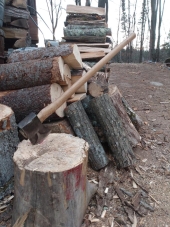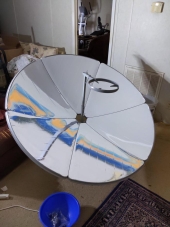I have a tracking solar cooker project that made good progress this year. Its experimental, I'm trying to expand the reach of solar cooking so I don't cook food in it.
Instead, in a "play to get gardeners interested" I steam soil and I make weed soup instead of compost and compost tea.
Because I didn't know how good my new tracking system would be, I didn't go with a standard parabolic dish, instead going for something with a deeper curve, that doesn't concentrate the light as much, ( but the bonus is that it still concentrates well even if it isn't accurately aimed, plus it is less likely to hurt your eyes if it misses the target).
My tracking system was bulky at the start, now it's a lot smaller. And the latest version is a bit "steam punk". Its mostly made of wood, and It has a miniwaterwheel that "winches" the solar reflector around!
There are no electronics outside. It is all run on compressed air that comes from a pond air bubbler. It's a "time based tracker". The gradually increasing air pressure over the day in one pipe tells it where to point.

So, results? Are they good?
I steam soil in 7 liter batches, it cooks or simmers the whole day. 7 liters of soil with one liter of water added to prevent the soil burning. I used it first to grow seedlings (no weeds) so they have no competition. They "seem" to do better. The real test was accidental. I was planning a planter with just solar cooked soil over a layer of solar cooked weeds. BUT, I ran out of solar cooked soil half way. So, I just used ordinary soil for the rest. WHAT A DIFFERENCE!
(In fairness I transplanted lettuce into the non cooked soil one day later than into the solar cooked). In the solar cooked soil, the lettuce is significantly bigger and a darker green. And there is an explanation. The weed seeds, bulbs, stolons and tiny bugs, and bacteria have been cooked and they have released their juices into the soil. New bacteria quickly colonized it and converted a lot of this stuff into plant food. And the plants, without pathogens or soil insects eating their roots and making them sick, grew faster.
Weed soup is the 7 liter pot packed with chopped weeds, tamped down and water added to the top. Put on the solar cooker, and track for the day, If it gets to about 80 C its good enough. (Usually gets to over 90 and simmers most of the day if its sunny). I use the soup water at about one in 20 in my watering can like compost tea. Seems to have given my beans a big boost. (It's carbohydrate and nutrients for the soil bacteria). Probably helped the other plants too. I have used the dry part of the cooked weeds mostly as mulch. It rots down really fast, and the worms seem to love it.
Advantages? I can use tomato clippings back on tomatoes, (because they are cooked). Blackberry smells like strong rose perfume when it is cooked, fennel smells great too, and even my mulch has a great scent when I put it on. And instead of waiting 3 months to get the value out of compost, I get the weed nutrients the very next day, plus the carbohydrates can work right there in the soil to boost plant growth immediately, (instead of just doing rotting in the compost heap. I am putting in a link to a playlist, because it is a big project.
The beauty of this system is that you reset it every evening, and put the next batch on (if it wasn't cloudy all day) and you can safely ignore it all day till next evening. Here is the playlist
https://www.youtube.com/playlist?list=PLkzXlmAwZTZdwFHYgD8mp4RFg2-Ap-ZNy and here is one of the vids in case the playlist link doesn't work
https://youtu.be/IKMkPy4kkTY











